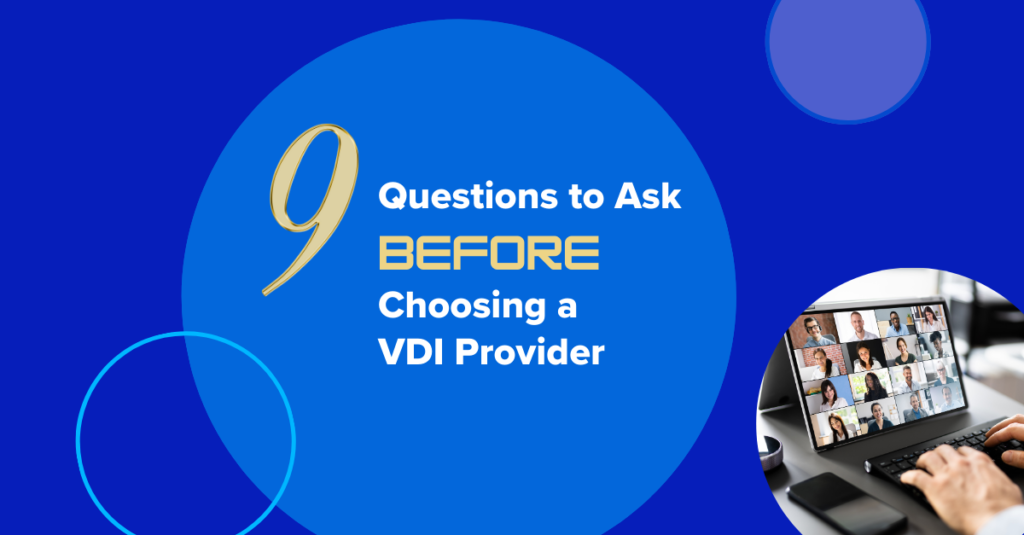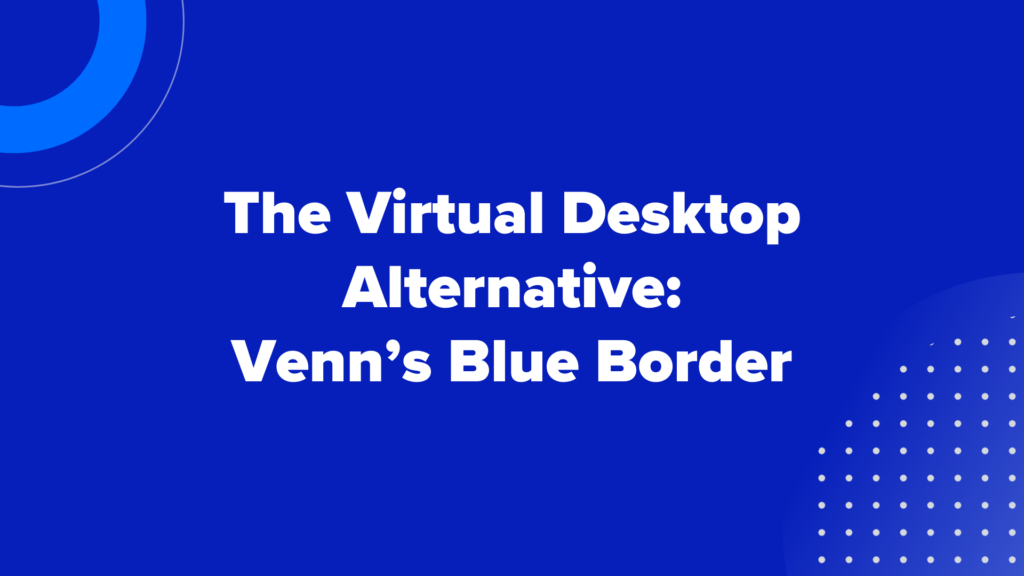Ready to Choose a VDI Provider? Ask These 9 Questions First

The business world is riding a wave of change as remote work reshapes our approach to the daily grind. Gone are the days of juggling separate work and personal computers – now, it’s all about one device that does it all. These devices need to keep up with our employee’s fast-paced lifestyle when it comes to performance, flexibility, and ease of use. But when it comes to work, they also need to provide the security, protection, compliance, and productivity that our job requires.
Here’s the thing. With so many personal devices and operating systems in use, it’s tough to find a uniform security strategy that balances user privacy with convenience and stands up to the constantly evolving nature of cyberattacks–all while ensuring compliance with a myriad of data protection laws. This blend of technical, legal, and human factors makes choosing a secure BYOD solution a complex task.
Virtual Desktop Infrastructure, or VDI, has long been the de facto approach to protecting apps and data on remote and unmanaged computers. A VDI solution provides enhanced security by centralizing data and reducing the risk of breaches but comes with setup complexities and potential user frustrations.
If you’re looking into VDI solutions, this blog will help you line up your company’s needs and determine if it is right for you. We’ve compiled a list of questions that will help you understand whether the VDI vendor you’re looking at can provide you with a practical, high-performing, secure solution – before you make a final decision. And if you’re not sure that VDI is for you, check out this alternative solution.
Question #1: How easy is it to set up your solution?
Setting up a VDI can be complicated for the IT Team and adoption can be frustrating for users. You need to make sure your VDI is easy for users to get started and adopt, so there is no price to pay in terms of productivity. But what about the IT teams? Complicated configurations can introduce deployment challenges.
To determine if this VDI is simple to get up and running, ask questions like:
- How easy is it to set up your solution across a distributed global workforce? Can you give me some real-life examples?
- How long does it typically take to get the solution up and running per user? For 200 users? For 1,000? How about 20,000?
- Does the process involve meticulous configuration, integration, and testing?
- What kind of in-house IT skills do I need? Are these experts hard to find or costly to hire? Do I need to hire consultants?
- What challenges can I expect when deploying the solution?
Question #2: What IT efforts are needed for ongoing management?
A solution that is both easy-to-use and manage is crucial to keeping the business running smoothly. It should enhance employee productivity by cutting down on the time they spend learning and troubleshooting. This means employees can focus on their core business tasks, and so can you. Overall, it shouldn’t require employees or IT to undergo extensive training and support so business operations stay agile and resilient, without being bogged down dealing with the VDI.
To assess how straightforward it is to deploy this VDI, consider asking:
- How much effort will IT need to invest in managing, patching, and maintaining the solution over time? What can I expect in terms of time and frustration?
- Can you give me an example of how much time IT will need to devote to helping our employees use the solution?
- What kind of training will IT require to keep our business agile?
- Will a responsive support team be there for me when things go sideways?
- What kind of service level can I expect for support tickets?
- Does the solution include comprehensive documentation?
- Is it intuitive for users or will IT be fielding calls from angry or remote users at all hours of the day and night?
Question #3: How much will your infrastructure require from my budget?
Staying resource-efficient is vital to help businesses optimize costs and improve profitability by reducing waste and maximizing the use of existing resources. Deploying a VDI solution has many associated costs, including a heavy initial investment upfront and the less obvious ones that are ongoing over time—when glitches and latency prevent people from getting right to work. Keep in mind that any solution needs to scale as traffic goes up – whether due to company growth or trends that increase the volume of data.
To understand the expenses associated with this VDI, you might ask questions including:
- Will I need special servers or more team members?
- What exactly can I anticipate in terms of backend infrastructure costs, both CAPEX and OPEX?
- How will my costs change over time, as the infrastructure and traffic volume grow?
- Do you have a cost-effective alternative remote connectivity solution that doesn’t involve piping data and apps through our company networks?
Question #4: Will my users be happy? Will they be productive?
Today’s users expect work applications to be fast and agile. They don’t have the time or patience for apps to load or to wait for IT to ship laptops. Any learning curve involved in onboarding them or hiccups during use will be bad for the workforce productivity and customer experience–especially when it comes to call agents or support centers. Connectivity needs to be a smooth experience that at the very least measures up to working at home on their preferred system—whether on PC or Mac.
To understand how intuitive your users will find this VDI, pose questions like:
- What is the learning curve like for users and how long will it take for them to feel comfortable with the system up and running?
- Will they have to follow new workflows or processes to log in, open, and work in applications?
- Will it be easy for my workers to switch back and forth between their personal area on the computer and their work area as needed?
- Will the VDI impact my workers’ productivity? What can I expect in terms of latency, jitter, or hangups?
Question #5: Is my data secure?
In a VDI environment, keeping data secure is paramount because it centralizes sensitive information, which demands robust protection against leaks, breaches and cyber threats. Effective data security in VDI not only requires compliance with data protection regulations but is a must for maintaining trust in business operations and client relationships.
To explore data security issues, ask:
- Which security measures are in place to protect my company data?
- What kind of protection will I have from cyber-attacks or insider threats?
Question #6: Will I be compliant?
We’re seeing a growing need to meet compliance regulations for data protection and privacy, especially across certain industries like healthcare and finance. Ensuring compliance is crucial to avoid legal repercussions and hefty fines, but it also goes a long way toward reinforcing the company’s credibility and reliability in handling sensitive information.
To be sure it’s straightforward to stay compliant, as questions like:
- Will the solution keep my organization compliant for HIPAA, PCI, FINRA and others?
- Are there regulations that you are not able to cover?
- How does the solution monitor compliance and meet reporting requirements?
- Do you provide alerts about compliance violations?
- How difficult is it to update the system so it meets new regulations or changes in old ones?
Question #7: Will my applications perform as expected?
Application performance in a VDI environment is critical because it directly impacts user productivity and satisfaction. What’s more, applications that perform poorly in VDI can reduce the integrity of work processes and adversely impact the quality of service delivered to end-users or customers. For example, if connecting to SaaS applications requires going through the company VDI before connecting to the internet, this can seriously affect performance.
To explore how this VDI will impact operations, remember to ask:
- How will application performance be affected when it comes to latency, jitter, and hangups?
- Will my customers feel a difference in the quality of service?
- Will I see a difference between the performance of SaaS applications as opposed to client-service applications?
- What solutions do you have for connecting to SaaS applications?
Question #8: Are you the right fit for my business size?
The investment you make in a VDI needs to be proportionate to your organization’s actual needs and expected benefits. An overly complex or expensive solution for a smaller business can lead to unnecessary financial strain and underutilization of resources, while one that is too basic for a larger enterprise may not meet the required scalability and functionality. The right fit will ensure an optimal balance between performance, scalability, and cost-effectiveness, aligning the technology with your business’s current and future objectives.
To gauge whether this VDI is a good fit, ask questions including:
- Is your solution suited for SMBs or larger enterprises?
- Are you able to align the cost and complexity if the size of my business changes?
Question #9: Can you scale up and down with my company’s needs?
Swift and safe onboarding and offboarding and connecting third-parties are crucial for any business, but can be challenging in a VDI environment due to the complexity of configuring and customizing virtual desktops to meet specific user needs and roles. This process often involves meticulous management of access permissions and integration with various company resources and applications, which can be time-consuming. Additionally, ensuring data security and compliance during offboarding, especially when revoking access and securely erasing user data, adds another layer of complexity to the process. With M&As, it’s the same complexity but on steroids.
To understand how easy it will be for you to scale the VDI up or down, ask questions like:
- How long will it take to get hundreds or thousands of new workers up and running quickly? And what about third-party contractors?
- What’s involved in offboarding users? Will I need to revoke access to the virtual desktop environment, transfer or archive the user’s data, remove any installed applications or customizations specific to the user?
- How do I ensure that any licenses associated with the user are appropriately managed?
- Can the technology easily scale up or down on demand to align with my business as we change?
Next Steps
Once you have the answers to these questions, assess how each VDI solution aligns with your specific needs. Consult users to gain insight into app needs and ask the VDI solution provider for a detailed deployment walkthrough.
An Alternative approach
Before you reach a final decision, make sure to consider alternative solutions that may better meet your needs and use cases. One example of a great alternative to VDI is the Secure Enclave from Venn. Venn secures remote work on any unmanaged or BYOD computer with a radically simplified and less costly solution than virtual desktops. Similar to an MDM solution but for laptops – work lives in a company-controlled Secure Enclave installed on the user’s PC or Mac, where all data is encrypted and access is managed. Work applications run locally within the enclave – visually indicated by the Blue Border™ – where business activity is isolated and protected from any personal use on the same computer.
Venn requires zero backend infrastructure. It’s a patented software-based solution that puts a virtual wrapper around work applications running locally on the computer. It’s simple to use, cost-effective and easy to support. It’s secure and complies with regulatory requirements, and companies can onboard and offboard remote workers in minutes. Security and compliance-driven organizations can now easily protect company data on any unmanaged or BYOD computer without the cost and complexity of VDI.
Interested in a simpler, more cost-effective alternative to traditional VDI? Explore how the Venn Secure Enclave can empower your team with a solution that balances freedom with ease-of-use, security and compliance.
More Blogs



